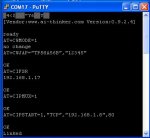agalmarini
New Member
Hi!
I've some strange problem with the RF receiver (NKM2401+14M2) circuit connected to the PC (via sertxd).
Everything is working fine, with the exception of the firtst byte.
For example, if the Transmitter sends "Test1234", I receive in the PC: [F5]est1234
Any idea to solve the problem is more than welcome!

Below I'm enclosing the code. The ciruit is the standard one (AXE213).
Thanks for your help!
Agustin
I've some strange problem with the RF receiver (NKM2401+14M2) circuit connected to the PC (via sertxd).
Everything is working fine, with the exception of the firtst byte.
For example, if the Transmitter sends "Test1234", I receive in the PC: [F5]est1234
Any idea to solve the problem is more than welcome!
Below I'm enclosing the code. The ciruit is the standard one (AXE213).
Thanks for your help!
Agustin
Code:
symbol pinDATA = B.4
symbol pinREADY = pinB.3
symbol pinSEND = B.5
symbol pinLED = C.0
main:
low pinSEND
high pinLED
MainLoop:
low pinSEND
if pinREADY=1 then goto MainLoop
high pinSEND
serin pinDATA, n2400,b0,b1,b2,b3,b4,b5,b6,b7
low pinSEND
sertxd (b0,b1,b2,b3,b4,b5,b6,b7,CR,LF)
goto MainLoop
